Learn how to make natural DIY hand sanitizer with high-proof vodka instead of rubbing alcohol. This easy tutorial includes recipes for both spray and gel formats. Both versions are useful for travel and for those times when you don’t have access to soap and water.
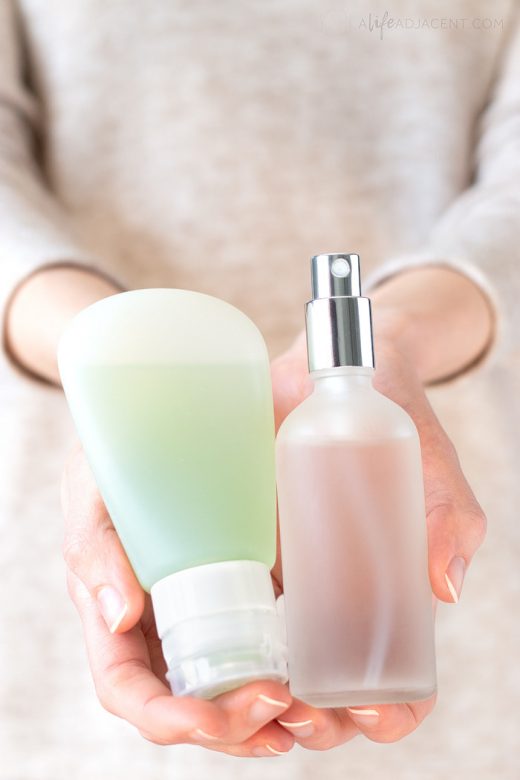
Last Updated May 28, 2021
When cold and flu season strikes, the best defence is to simply wash your hands more frequently.
However, sometimes for various reasons, you might not have access to soap and water. And in those circumstances, hand sanitizer is incredibly useful for helping to prevent illness.
But while store bought hand sanitizers are effective, their ingredients are sometimes problematic. And in the event of a shortage, it’s good practice to know how to make your own sanitizer using safe household ingredients.
Therefore, we wanted to offer natural and effective alternatives that you can make at home when store-bought products aren’t available.
Depending on your preference, you can choose between hand sanitizer spray or hand sanitizer gel. Both recipes contain over 60% alcohol to kill germs without the unpleasant scent of rubbing alcohol.

Natural DIY Disinfecting Wipes
When to use hand sanitizer
According to the CDC, hand washing is still one of the best ways to protect yourself from cold and flu, as well as the current viral outbreak.
But remember that you should not rely on hand sanitizer in place of regular hand washing. As well, it’s important to note that hand sanitizer does not kill all types of bacteria, parasites, or viruses such as norovirus.
It also doesn’t remove pesticides, heavy metals, or other harmful chemicals from your hands.
For more information on hand washing and hand sanitizer use, see this factsheet from the CDC.
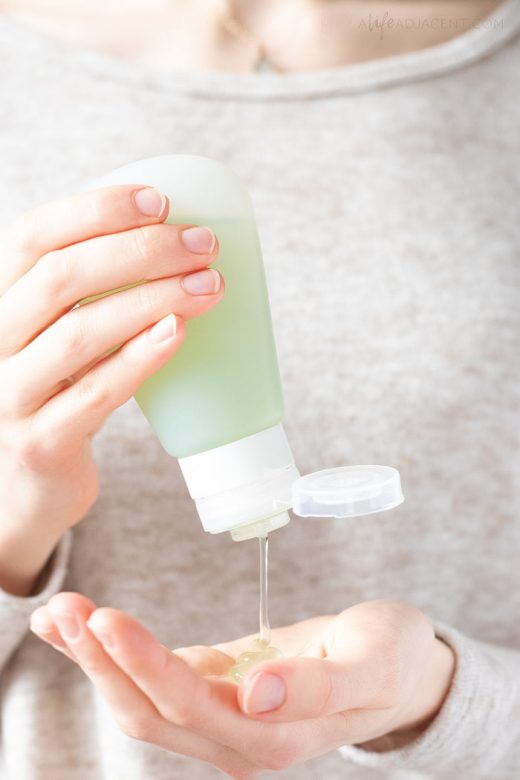
Why our recipe is made without rubbing alcohol
We have seen countless DIYs recommending a rubbing alcohol and aloe vera gel formula.
Yes, rubbing alcohol is an effective disinfectant. But personally, we prefer to avoid rubbing alcohol in all of our homemade products, which is why we chose to make this hand sanitizer high-proof with vodka instead of rubbing alcohol.
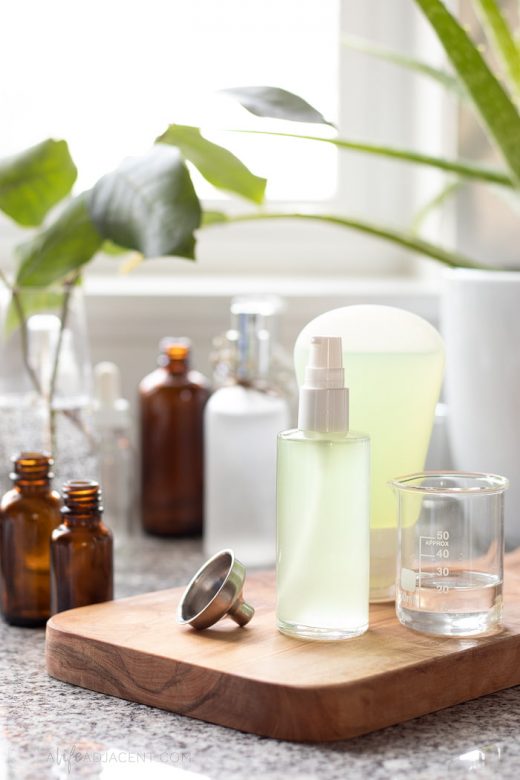
Small amounts of any undesirable ingredient may be fine, but we aim to cut down on our cumulative exposure whenever possible. When we have the luxury of choosing a safer, non-toxic alternative over a potentially harmful product, we will choose the former.
For this reason, we also avoid rubbing alcohol in our homemade cleaning products, opting instead for high-proof vodka in our disinfecting wipes, cleaning spray and glass cleaner recipes.
The problems with rubbing alcohol
Using rubbing alcohol (also known as isopropyl alcohol or isopropanol) may be considered safe, but there’s a reason each bottle carries poison warnings.
Inhalation and prolonged exposure to isopropanol fumes can cause headaches, vomiting, nausea and migraines in some people.
Since two people in our home suffer from chronic migraines, it’s important for us to avoid migraine triggers whenever possible.
But it’s not just inhalation that can pose an issue. Prolonged skin exposure to isopropyl alcohol can cause redness, rash, and extreme dryness and cracking. It can even trigger allergic contact dermatitis in susceptible individuals.
Small amounts are generally fine for most people, but for those with skin conditions like eczema, rubbing alcohol-based hand sanitizers are likely not ideal.
As well, it’s been proven that isopropanol is readily absorbed through the skin, with large amounts having the ability to cause accidental poisoning. Prolonged topical exposure can even cause cardiac and neurological side effects.
It’s even more dangerous for children, as their smaller bodies are less equipped to process isopropanol. Using large amounts on or near children for a prolonged period of time should always be avoided, as this increases the risk of toxicity.
Of course, this is not meant to fear monger. Using a small isopropyl alcohol to sanitize one’s hands is likely not going harm to an average adult. And when faced with using rubbing alcohol or risking infection, you’re still better off using a product containing rubbing alcohol than forgoing a disinfectant.
But considering rubbing alcohol’s risks, and especially its toxicity to children, we want to offer a safer option.
Make your own hand sanitizer with vodka
It’s a misconception that you can’t use vodka to make your own homemade hand sanitizer. You can, but with one caveat: you must use high-proof vodka.
According to the CDC, a hand sanitizer must contain at least 60% alcohol in order to be effective against viruses like the one causing the current outbreak.
Regular vodka is only 40% alcohol, so you should not use any vodka brand off the shelf. But as long as the final product contains at least 60% alcohol, it’s safe to make your own hand sanitizer with high-proof vodka.
The only difference is that vodka contains pure ethyl alcohol, or ethanol, rather than isopropyl alcohol.
Pure ethanol is not toxic to skin, does not have to be used in a well-ventilated area, and is not as dangerous if ingested. The same cannot be said for rubbing alcohol.
Disclaimer: Even though we have followed the CDC’s recommendations, we cannot guarantee that your hand sanitizer will protect against viruses.
Hand sanitizer should only be used as a last resort. It’s your responsibility to protect yourself and to follow good hygiene practices such as frequent hand washing and not touching your face.

DIY hand sanitizer recipes that DON’T work
We became concerned with the increasing panic and how this could potentially cause people to turn to ineffective and dangerous DIYs.
Unfortunately, there are a lot of “natural” hand sanitizer recipes on the internet. Some of them are likely ineffective and at worst, downright harmful.
So, to help combat the spread of dangerous misinformation, we want to highlight some of the recipes that should be avoided.
Aloe vera and essential oils
It’s true that essential oils like tea tree oil, thyme oil, and cinnamon oil, to name a few, possess some antibacterial and antiviral activity.
However, in order to be effective, these essential oils would likely have to be used in such high amounts that they would potentially burn the skin.
A mixture of aloe vera gel and a few drops of essential oils is also not effective enough to kill illness-causing viruses or bacteria.
Witch hazel and essential oils
Contrary to popular belief, witch hazel is not a comparable alternative to alcohol. Even the strongest witch hazel extract is at most 14% ethyl alcohol.
Witch hazel extract is a useful ingredient for DIY skincare, but 14% alcohol is not enough to kill viruses or other pathogens.
Again, essential oils can certainly help boost a natural hand sanitizer’s antiseptic properties, but they should not be used as a sole disinfectant. And since 60% alcohol is enough to kill most germs, essential oils aren’t actually necessary in a hand sanitizer recipe.
Any kind of hand sanitizer without alcohol
It’s just not possible to create a safe and effective homemade hand sanitizer without alcohol.
Though store bought options exist using antibacterial agents like benzalkonium chloride, the CDC has stated that alcohol-free hand sanitizers are not as effective as alcohol for many kinds of pathogens.
How to make an effective hand sanitizer
As mentioned, in order for a DIY sanitizer to be effective, it needs to contain at least 60% alcohol.
As well, slightly more alcohol may be desirable – according to this paper, a concentration of 62%-71% ethanol significantly reduces virus infectivity within 1 minute exposure time.
Aside from a high percentage of alcohol, you should also choose a moisturizing agent to keep your hands from drying out. We chose vegetable glycerin as the humectant in our hand sanitizer spray, and aloe vera gel for our hand sanitizer gel.
You can also opt to add a few drops of antibacterial essential oils for fragrance, such as eucalyptus, cinnamon, or tea tree oil. But the main sanitizer in this recipe is alcohol.
Ingredients for natural DIY hand sanitizer
High-proof vodka
In order to be effective against germs, you must use high-proof vodka or grain alcohol in this DIY.
If making the spray version, you can choose a vodka that’s between 70%-95% alcohol (140-190 proof).
But if you’re making the gel version of this recipe, you should choose a vodka with at least 90% alcohol (180 proof). Since you’ll be diluting it with aloe vera, it’s important to start with a high alcohol percentage.
If you live in an area where Everclear is legal for purchase, it’s ideal for this recipe. Everclear is a high-proof grain alcohol bottled at 120, 151, 189, and 190 US proof.
For the spray hand sanitizer, you can use Everclear 151, 189, or 190. But for the gel, you should choose 189 or 190.
Depending on where you live, other options may be available to you. Classifications may vary by country, so make sure to double check the alcohol percentage of your particular brand.
Other high-proof vodka options include:
- Spirytus Rektyfikowany – 96% alcohol or 192 proof
- Devil Springs Vodka – 80% alcohol or 160 proof
- Good ol’ Sailor Vodka – 85% vodka or 175 proof
- Balkan 176 – 88% alcohol or 176 proof
- Pincer Vodka – 88% alcohol or 176 proof
Vegetable glycerin
To add a moisturizing quality to our hand sanitizer spray, we used a small amount of vegetable glycerin.
Vegetable glycerin is a humectant that helps attract and bind moisture. This helps mitigate the drying quality of the alcohol. Glycerin is also ideal for those who would like to make a hand sanitizer without aloe due to allergy or a lack of availability.
Aloe vera gel
We used aloe vera gel to create a moisturizing base for our hand sanitizer gel. The polysaccharides in aloe act as humectants that help keep your hands from drying out.
As well, aloe vera gel helps thicken this sanitizer to a gel consistency.
Although, depending on your particular brand of aloe vera gel, your sanitizer may not thicken as much as you’d like. See our notes below on thickening homemade hand sanitizer.

Essential oils
Though essential oils aren’t necessary, they can help add a nice scent and extra antibacterial properties to this recipe.
However, if you have sensitive skin, we don’t recommend adding any essential oils to your hand sanitizer. Most essential oils have sensitizing properties that can irritate sensitive or eczema-prone skin.
Natural green dye
Real aloe gel isn’t green, but we added a single drop of natural green food dye to our hand sanitizer gel for a pop of colour. Of course, this step is completely optional.
How to make hand sanitizer spray
For measurements, consult the recipe card at the bottom of this post.
- In a glass spray bottle, combine vodka with glycerin.
- Add a few drops of essential oils, if desired.
- Shake to combine.
How to make hand sanitizer gel
See the recipe card for exact measurements.
- In a mason jar with a lid, combine vodka with aloe vera gel.
- Stir until thoroughly combined. You can also choose to add a thickener (instructions below).
- Using a funnel, transfer your gel into a pump or squeeze bottle.
How to thicken homemade hand sanitizer
Depending on which brand of aloe vera gel you use, you may find that your hand sanitizer gel may not turn out quite as thick as you’d like. So for those who would prefer a more viscous final product, you may wish to add a thickener to your recipe.
We had previously suggested several different options, but we’ve since discovered that most natural thickeners are too hard to work with when your product contains alcohol.
Unfortunately, we also discovered that the previously suggested thickeners may cause the sanitizer gel to separate over time. For this reason, we’ve removed our thickener recommendations.
To learn how to thicken your homemade hand sanitizer, we suggest reading this post on DIY hand sanitizer by The Things We’ll Make. She tested several different hand sanitizer thickeners and gives a detailed breakdown of the ones that are most effective when making a gel sanitizer.
How to store your hand sanitizer
We recommend storing your hand sanitizer spray in a small glass spray bottle to keep things eco-friendly. But if glass is not convenient or available to you, you can also opt for a stainless steel or plastic spray bottle.
If you’d like to bring your sanitizer on the go, tiny, purse-sized spray bottles are very useful.

If making the gel version of this recipe, you can choose a glass pump bottle or a plastic squeeze bottle.
In any other situation we would recommend a reusable silicone squeeze bottle instead. However, alcohol can break down silicone, making silicone bottles incompatible with this DIY.
It’s important to note that essential oils are potent and can break down plastic. So if you’re going to store your hand sanitizer in a plastic container, you should skip the essential oils.
How to use this natural hand sanitizer
In order for a hand sanitizer to be effective, it must be used properly.
Be sure to shake the bottle well before each use. Dispense a generous amount into the palm of your hand. Rub your hands together, making sure to cover all surfaces of your hands, including the backs of your hands and between each finger.
Continue until all areas have been covered and your hands are dry.
You can also use your disinfecting spray to disinfect surfaces like door handles, steering wheels and tables when you’re on the go.
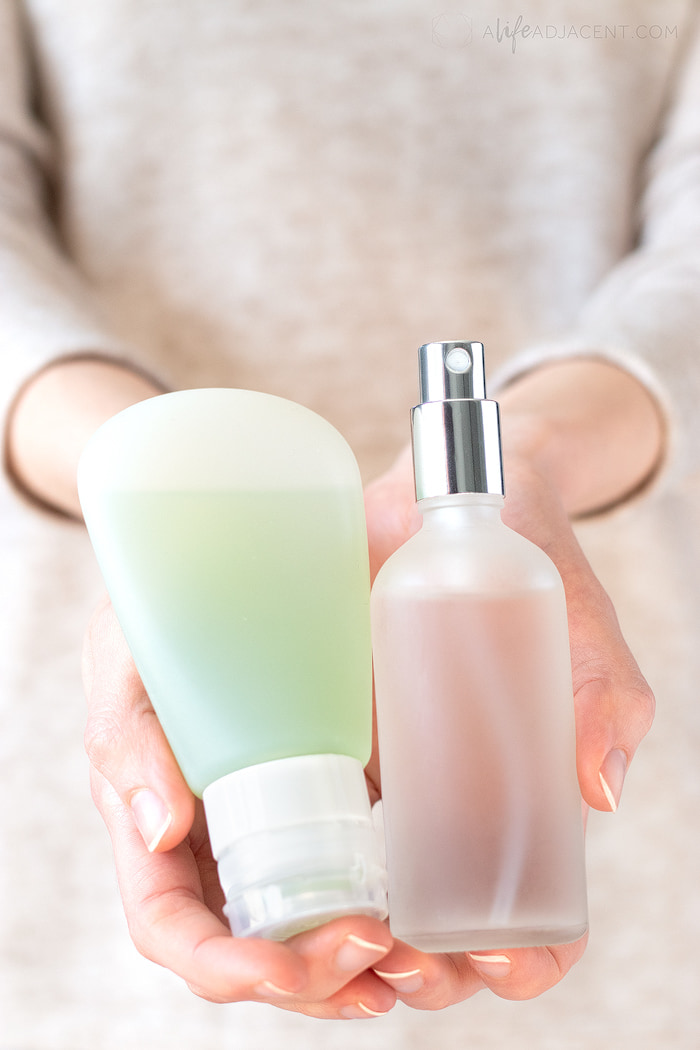
DIY Hand Sanitizer with Vodka (2 Ways: Spray or Gel)
Learn how to make a natural DIY hand sanitizer in a convenient spray or gel. This easy recipe contains high proof vodka to kill germs without the unpleasant scent of rubbing alcohol.
Materials
DIY Hand Sanitizer Spray
- 1/2 cup high proof vodka (at least 70% alcohol)
- 1 tsp vegetable glycerin
- A few drops of essential oils (optional)
DIY Hand Sanitizer Gel
- 1/2 cup high proof vodka (at least 90% alcohol)
- 1/4 cup aloe vera gel
- A few drops of antibacterial essential oils (optional)
- A drop of natural green food dye (optional)
Tools
- Glass beaker or mason jar for mixing
- Glass spray bottle (or stainless steel)
- Glass pump bottle or plastic squeeze bottle
Instructions
- Pour your vodka into a clean container. If making the gel, use a mason jar or a container with a lid. If making the spray, you can also opt to use a glass beaker.
- Add either glycerin or aloe vera gel, depending on whether you're making the sanitizer spray or gel.
- Mix well to combine. If making the gel, you can also opt to add a thickener (see recipe notes).
- If desired, add a few drops of essential oils, but skip them if you'll be storing your sanitizer in a plastic container.
- Using a funnel, transfer your hand sanitizer spray into a glass spray bottle. If making hand sanitizer gel, transfer it into a glass pump bottle or a plastic squeeze bottle.
Notes
Depending on which brand of aloe vera gel you use, you may find that your hand sanitizer gel may not turn out as thick as you'd like. So for those who would prefer a more viscous final product, you may wish to add a thickener to your recipe.
Please see the section on how to thicken DIY hand sanitizer for more information.
If making the spray version, you can pour your ingredients directly into your spray bottle. But if making the gel sanitizer, it's important to combine in a separate container first for easy mixing.
Please note that alcohol isn't compatible with silicone. As well, essential oils can break down both plastic and silicone. Please do not use a silicone squeeze bottle for your hand sanitizer gel. And if adding essential oils to your hand sanitizer, do not use a plastic container to store it.
Recommended Products
As an Amazon Associate and member of other affiliate programs, we earn from qualifying purchases.
More natural cleaning recipes
Looking for more natural and green cleaning recipes for a non-toxic home? You may enjoy:
- DIY Disinfecting Wipes with Essential Oils
- DIY Air Freshener Jars with Essential Oils
- Rose Petal-Infused Vodka Cleaning Spray
- Make Your Own Liquid Soap from Bar Soap
- DIY Glass Cleaner with Gin
For even more natural DIY bath and body ideas, follow us on Pinterest! You can also find us on Instagram, Facebook, and Twitter.
Pin it for later
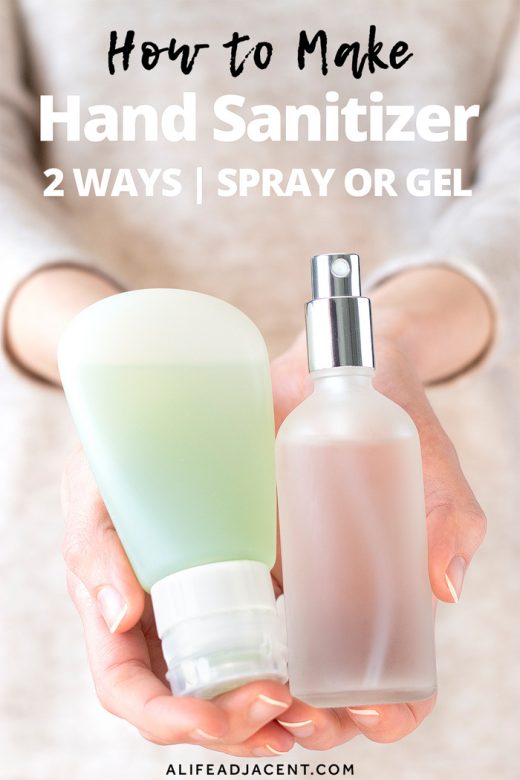
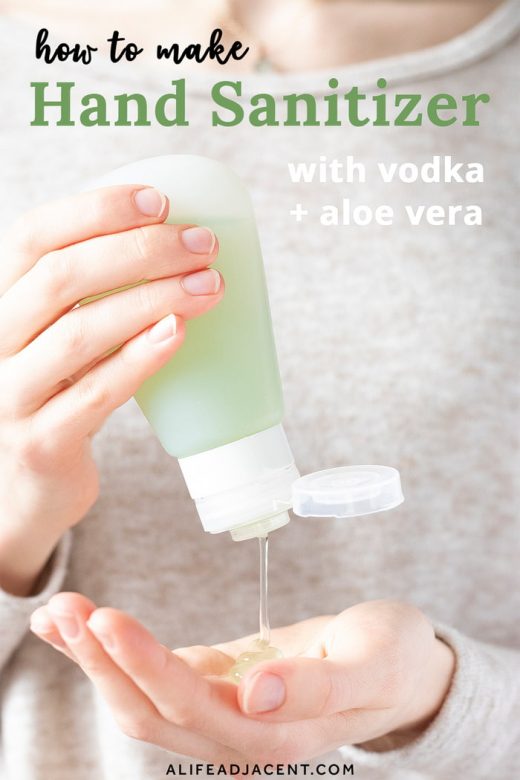

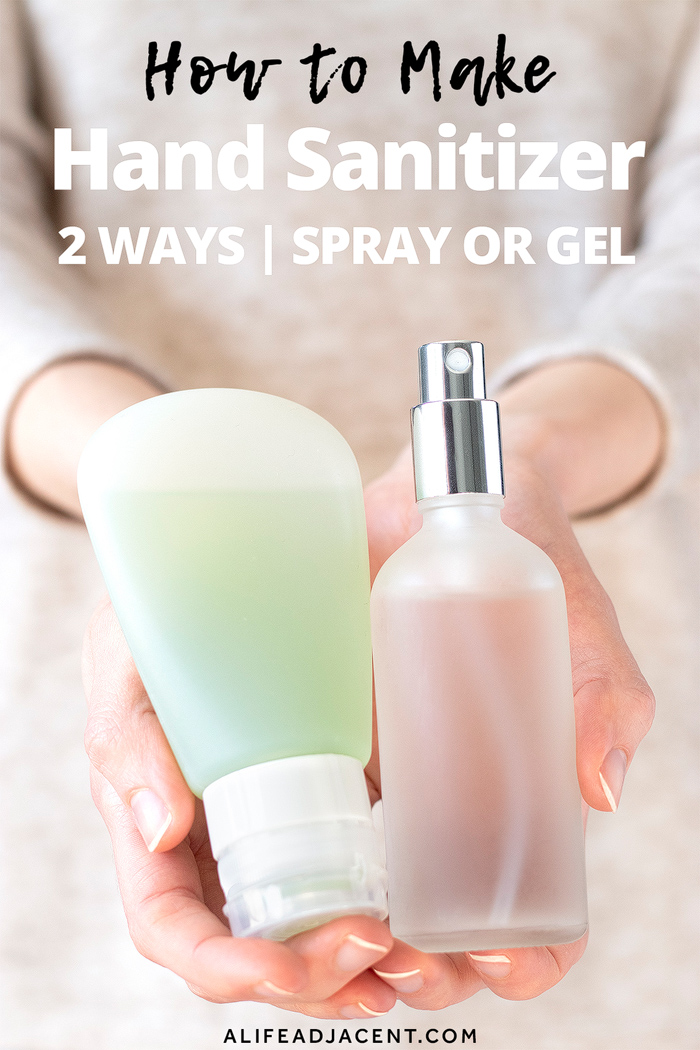





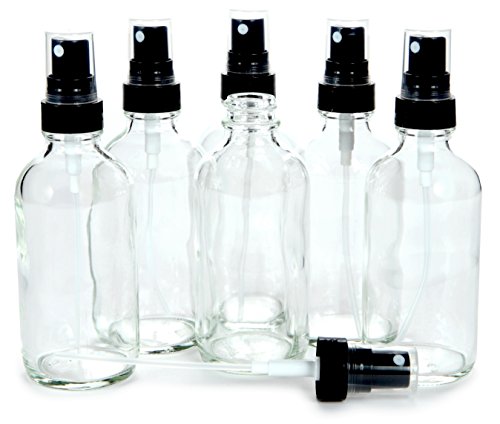

Rhonda Crosby
Thursday 14th of January 2021
I have a small stash of hand sanitizer gel but don’t like the way gel feels on my hands I do like using hand sanitizer “spray” Is it possible to “turn” the gel into spray? Plz help
Kyla
Thursday 14th of January 2021
Hi Rhonda, to be honest, I'm not sure. I think you may be able to mix the gel with more alcohol to thin its texture. But the product you mix it with would have to contain at least 60% alcohol to avoid reducing the hand sanitizer's efficacy. Something like Everclear 151 might work. But again, I can't say for sure. Whether this works or not will depend on your gel's formula and ingredients.
Lizbeth Garcia
Saturday 31st of October 2020
Hello! I have one question, can i substitute the vodka with other alcohol, like mezcal? Where i live is more easy and cheap to find high grade mezcal than vodka.
Kim
Sunday 1st of November 2020
Hi there! It would depend on the alcohol percentage. We're not familiar with mezcal but a quick search indicated it varies in % so as long as you used a brand with a high enough percentage that follows the guidelines we outlined in the article, it should work. But again, if the brand doesn't have a high enough percentage of alcohol, it won't adhere to the guidelines so in that case, we wouldn't recommend using it. Hope that helps!
Bim
Monday 28th of September 2020
Is it necessary to have the vegetable glycerine? Is there any substitute? Thank you.
Kim
Monday 28th of September 2020
Hi Bim, Yes, you need a moisturizer when using a product with high alcohol content or you will risk get dry, cracked hands. Vegetable glycerine is very inexpensive. You can also use aloe vera gel. Hope this helps!
Brandy
Friday 12th of June 2020
Can you use vitamin E or a carrier oil (jojoba, grape seed, sunflower) in place of the glycerin? Thanks!
Brandy
Saturday 13th of June 2020
@Kim, Thanks!
Kim
Friday 12th of June 2020
Hi there! No, we don't recommend those options as they won't combine readily with the alcohol.
Cynthia
Saturday 6th of June 2020
was getting desperate because I was on my last bottle of lavender scented spray sanitizer. Just mixed up a batch of the spray sanitizer using the Everclear and lavender essential oil. (Was unable to find a high enough alcohol percentage vodka anywhere.) This smells and has the same clean feel as my favorite but way way overpriced product.Thanks so much, I doubt I will ever buy hand sanitizer again!
Kim
Thursday 11th of June 2020
Glad this recipe worked out for you, Cynthia!